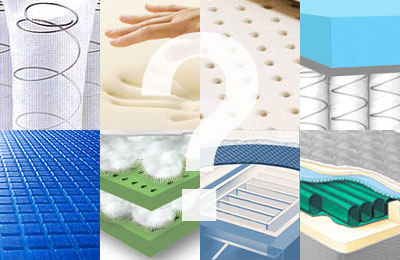Starting point of your quest to find a great new mattress

You came to the conclusion that it is time to replace your old mattress. Like many other shoppers, you are not particularly excited about it, but now that it’s on your list it needs to be taken care of. As a responsible consumer you are getting ready to dive into long hours of research with the goal of finding the right mattress that will serve you well for many years, and this is just the place you want to start.
One of the first decisions you face is choosing one or two mattress types that match your criteria and that you will focus your research on. Putting it another way, your first task is to simply eliminate the mattress types that don’t fit your requirements and that you are not particularly fond of. So, which is the best mattress? We cannot answer this question for you, but will provide you the tools to make it much easier and more efficient. Below is a brief summary of the pros and cons for each mattress type to help you with your decision.
Innerspring mattresses pros and cons
The most commonly owned and sold type is the traditional innerspring mattress, in which the support system is made up of steel coils, coming in different shapes and forms. All of the better mattresses nowadays use independently pocketed coils providing even support, better contouring of your body, reduced motion transfer and improved durability.
Even though it is still the most popular breed, innerspring mattresses generally tend to have below-average durability due to excessive sagging – the state when a mattress develops deep body impressions (typically greater than 1.5”). The less expensive models lack motion separation, are prone to making noise and can be very bouncy.
| Pros | Cons |
|---|---|
| Initial support and comfort | Sub-par owner satisfaction |
| Great value | Below-average durability |
| Heat retention | Inferior pressure relief |
| Traditional feel | Poor motion separation |
| Product variety | Prone to collect dust mites, allergens |
| Availability | Possible sounds from springs |
Learn more about innerspring mattress - construction, coil count and quality, warranties, etc here
Memory foam mattresses pros and cons
Memory foam, also referred to as visco-elastic foam, is a material known for its superior pressure relieving quality, which helps reduce tossing and turning. The benefits of memory foam include being supportive, pressure relieving, durable, resistant to bacteria, mold, mildew, and mites. It reduces motion transfer across the mattress and provides a signature molding/melting feel. Higher quality products made from high-density foam of at least 5lb/ft3 are significantly heavier; they are typically firmer, and more durable with a shorter response time, or faster recovery to its original shape.
Memory foam does not breathe well and may become hot. For some, it is difficult to turn around in, and there are complaints about the ‘off-gassing’ of new mattresses causing respiratory irritation. High-density memory foam is not ideal for small children or adults with lower body weight since this does not allow for proper foam depression, causing insufficient back support. Less expensive products will be substantially thinner, generally made from only two layers, usually consisting of a polyurethane foam support layer, or support core, and a thin comfort layer of memory foam (1-2” only) on top.
| Pros | Cons |
|---|---|
| Customer satisfaction | Heat retention |
| Slow response time – molding feel | Inconsistent firmness |
| Pressure and pain relief | Difficult to turn and move in it |
| Above-average lifespan | Initial mattress odor |
| Allergen resistance | Lack of edge support |
| Availability | Weight and maneuverability |
Learn more about memory foam mattresses - construction, memory foam types and quality, warranties, etc here
Latex mattresses pros and cons
Latex mattresses are made from latex foam that could be natural, synthetic or a blend of the two. Latex is a great alternative for people who do not like the molding feel of memory foam but are still looking for a high quality, pressure-relieving product. Latex foam is more resilient than memory foam, providing exceptional durability, and making it easier to turn from one side to another. They are also hypoallergenic, and sleep quite cool in comparison to memory foam. Additionally, latex is the only mattress type in which the components can be certified Organic.
It can be more difficult, with latex, to decide on a product with the optimal combination of support and comfort. Some people cite a “spongy” feel and pronounced rubbery odor within the first couple of weeks. Also, doing research on latex products can be very confusing due to vague and incomplete specifications.
| Pros | Cons |
|---|---|
| All natural option | Initial mattress odor |
| Well-balanced support | Foamy, spongy feel |
| Fast response/recovery time | Limited information and availability |
| Long lifespan | Weight and maneuverability |
| Temperature control – breathability | Potential allergies |
| Mold, mildew, dust mites resistance | |
| Pressure relief |
Learn more about latex mattresses - construction, latex types and quality, warranties, latex brands etc here
Gel mattresses pros and cons
You can find a form of gel in any mattress type – innerspring, memory foam, latex and even air/dial beds nowadays may include a gel foam layer. There are mattresses, though, that are 100% made from gel. Gel offers several advantages, such as improved temperature regulation, better resiliency, superior pressure relief and increased durability.
Gel is a relatively new product, and only recently introduced to the mass market. Consequently, there is not enough data to confirm any longevity claims, but has been successfully utilized in hospital/medical settings. Although there tends to be a cooling effect of gel, it is rather temporary, and oftentimes unnoticeable. Research on this issue is unsubstantiated, with rival manufacturers disputing the claim, so make sure you spend your money wisely by focusing on all of the possible benefits of a gel mattress.
| Pros | Cons |
|---|---|
| Motion absorption and pressure relief | Limited information |
| Anti-microbial and hypoallergenic | Unique feel |
| Resiliency and faster response time | Insufficient history |
| Potential Cooling affect | Availability |
| Long Warranty |
Learn more about gel mattresses - construction, warranties, gel brands, etc here
Organic mattress pros and cons
Organic mattresses are natural, healthy alternatives to mattresses made with synthetic materials. There is currently no Organic Mattress that is USDA certified on the market. Some mattresses claiming to be organic are not whole finished products, but rather some of components they are built from are organic (natural latex foam, cotton, wool…)
Most of these organic/natural mattresses will have a latex foam support core with low-density latex foam comfort layers and various natural fibers on top. For the most part, these mattresses offer the same pros and cons that apply to latex mattresses, such as great support, pressure relief and durability. Moreover, organic/natural mattresses are made with less synthetic materials, have improved breathability and are environmentally friendly.
Organic mattresses with a latex core have a unique feel. These products have a limited availability, with most being found online. There may be a pronounced rubbery odor within the first couple of weeks, and doing research on organic/natural products can be very confusing due to vague and incomplete specs.
| Pros | Cons |
|---|---|
| Less exposure to chemicals | Vague specifications |
| Reduced allergic reactions | Initial mattress odor |
| Superior breathability | Limited information |
| Well-balanced support | Foamy, spongy feel |
| Pressure relief | Availability |
| Reduced impact on environment | Weight and maneuverability |
| Organic certification system | Insufficient history |
Learn more about organic mattresses - construction, warranties, gel brands, etc here
Hybrid mattress pros and cons
A hybrid mattress is a combination of the wrapped/pocket coil innerspring support system and innovative materials like memory foam, latex or gel foam on top. The union of these two cutting-edge technologies delivers the exceptional support of steel coils with the superior pressure relief and comfort of high-end foams. It feels more like traditional mattress but at the same time provides either the molding feel of memory foam or the unique feel of latex. Hybrid mattresses usually come with superior warranties but have not existed long enough to confirm their longevity. The overall quality of a hybrid mattress, along with its benefits and drawbacks, depends on the individual components it’s constructed with.
| Pros | Cons |
|---|---|
| Matching support with preferred comfort material | Insufficient history |
| More traditional feel | Unproven longevity |
| Faster response time | Innerspring support drawbacks |
| Improved motion separation | Memory Foam/latex/gel drawbacks |
| Good warranty | Availability |
Learn more about hybrid mattresses - construction, warranties, hybrid brands, etc here
Air/Dial mattress pros and cons
There are several manufacturers that currently offer air beds of various designs and quality levels. Superior models look and feel like traditional mattresses, with solid edge support and a fluffy pillow top, but with one major difference – the support/firmness can be customized on each side of the mattress independently. Air/Dial mattresses offer great pressure and pain relief and good motion absorption. Customer complaints include small air loss over time, somewhat loud operation (pump motor), below average warranty and uneven sleeping surface in lower end models. Be aware that some assembly required may be required after the mattress is delivered.
| Pros | Cons |
|---|---|
| Adjustable, personalized firmness | Failure of mechanical parts |
| Pressure and pain relief | Potential pump noise |
| Good motion separation | Requirement of an electric outlet |
| Above-average lifespan | Sub-par warranty |
| Maneuverability | Possible assembly required |
Learn more about air/dial mattresses - construction, types or mattresses, warranties, air/dial brands etc here
Waterbed mattress pros and cons
The main feature of waterbed mattresses is the use of a liquid support system, similar to how air is used in air/dial mattresses. The main benefits are their unique feel, temperature control and firmness/softness control in some models. With the latest improvements in construction and durability of waterbeds, there is currently a very low risk of puncture damage or bladder leakage.
Many common problems of the past have been eliminated, yet remaining concerns include initial odor, possible noise, weight and maneuverability, and necessary assemblage and maintenance.
| Pros | Cons |
|---|---|
| Temperature control | Potential punctures and leaks |
| Possibly adjustable firmness | Potential noise |
| Floating-like feel | Operating cost |
| Contouring to body | Weight and maneuverability |
| Pressure relief | Possibly assembly required |
| Long lifespan and affordability | Initial mattress odor |
| Affordability | Out of fashion |
Learn more about waterbed mattresses - construction, types of waterbeds, warranties, waterbed brands, etc here
